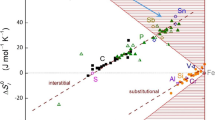Conclusions
-
1.
Direct visual observation of successive stages in the melting of thin strips of low-melting metals and alloys showed that melting always begins in the grain boundaries.
-
2.
The slip of the grains with respect to each other along the liquid layer under the influence of their own weight results in a visible relief on the surface of the samples that reflects the size and shape of the grains.
-
3.
The character of melting is affected by impurities, the surface film, the magnitude of the load, and the rate of heat flow to the sample.
Similar content being viewed by others
Literature cited
A. Ubbelode, Melting and Crystal Structure [Russian translation], Mir, Moscow (1969).
D. McLean, Grain Boundaries in Metals, Oxford Univ. Press, London (1957).
F. Weinberg, Acta Met., No. 5 (1957).
G. Chaudron et al., Compt. Rend., No. 226 (1948).
Additional information
Translated from Metallovedenie i Termicheskaya Obrabotka Metallov, No. 10, pp. 78–79, October, 1970.
Rights and permissions
About this article
Cite this article
Ivlev, V.I., Mal'tseva, G.K. The melting of grain boundaries. Met Sci Heat Treat 12, 891–892 (1970). https://doi.org/10.1007/BF00654488
Issue Date:
DOI: https://doi.org/10.1007/BF00654488




